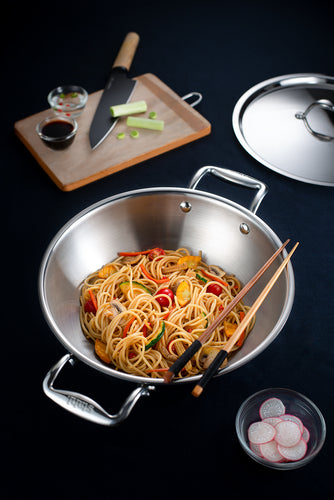My shopping cart
Your cart is currently empty.
Continue Shopping
An important decision that can impact the quality and longevity of your pots is selecting between Triply stainless steel vs stainless steel utensils for your kitchen. Triply and stainless-steel cookware are two popular options available today, and both boast durability and heat conduction properties. However, the difference between triply vs stainless steel cookware in terms of construction differs markedly in terms of performance metrics and maintenance demands.
This comprehensive guide examines the basic difference between triply and stainless steel. Understanding these aspects of tri ply cookware vs stainless steel will smoothen your decision-making process to enhance your culinary experience.
Read on to learn more about triply vs stainless steel.
Triply cookware, composed of three material layers - stainless steel, aluminium, and a final layer of stainless steel, offers multiple advantages. It facilitates even heat distribution, accelerates cooking times, enhances safety features, and offers durability. Owing to these merits, a boon for professional chefs and home cooks, it remains an enduringly popular choice. It's worth noting that Triply cookware like Stahl’s Steel Kadhai - Triply Artisan Series also boasts compatibility with induction stoves. Maintaining and cleaning them is also straightforward. Triply pressure cooker exemplifies this type of cookware.
The difference between triply vs stainless steel are as follows-
Triply cookware kadhai heats up and spreads heat more rapidly and evenly because of the combination of stainless steel and heat conducting core layers. In contrast, stainless steel may take longer to heat up and disperse heat less evenly.
Triply cookware has a stainless-steel exterior that is more robust and simpler to clean than standard stainless-steel cookware, which is prone to warping and scratching.
Triple cookware is simple to clean. However, stainless steel might be more complex and time-consuming.
Typically, triply is made up of stainless steel, aluminium, and an inner layer of food safe stainless steel. And, the stainless steel cookware primarily has a stainless steel construction.
The triply cookware is highly durable and resistant to warping corrosion. Similarly, stainless steel cookware is durable and resistant to dents and scratches.
Both triply cookware and stainless steel cookware are versatile in nature as they are suitable for various cooking methods and can be used on various cooking surfaces like stovetop, oven, and also with induction cooktops.
Regarding cost, there is slight difference between triply and stainless-steel cookware, primarily due to the materials and construction methods involved.
Tri ply stainless steel vs stainless steel utensils often leave you worried about the stains or stuck burnt food.
You need not concern yourself with hotspots and burns when you know about triply cookware. Its middle layer of aluminium aids in the distribution of heat evenly, while an outer magnetic steel layer renders it compatible with induction cooking. Furthermore, an inner surgical stainless-steel lining guarantees 0% contact between your food and potentially hazardous aluminium. This is a health-conscious feature over prolonged use.
For those who prioritize their family's health and want to embrace a healthier lifestyle, embarking on Stahl's triple-layered cookware like Triply Artisan Frypan with lid is an excellent first step. If you prioritize the safety and health aspects of your cooking, between triply vs stainless steel, the former emerges as an optimal cookware choice. Its superior quality indeed reflects a commitment to culinary excellence.
Stainless steel cookware is incredibly robust and may be used for various cooking methods, including searing, sautéing, and frying. It may also be used on any hob, including induction, conduction, or convection, and it easily transitions from the hob to the oven. This sort of cookware is durable and easy to clean. Sometimes there are chances of food sticking at the bottom of this cookware.
Both materials have their advantages: stainless steel offers durability and resistance to corrosion, while triply provides even heat distribution and retention, making it ideal for cooking delicate dishes. Ultimately, the choice depends on your cooking needs and preferences.
Tri-ply cookware offers superior heat distribution and durability compared to standard stainless steel, making it a preferred choice for many cooks. However, the decision depends on individual cooking needs and budget considerations.
Triply cookware provides uniform heat distribution and durability, making it an excellent investment for culinary enthusiasts.
Stainless steel cookware often has hot spots while cooking, resulting in chances of food sticking at the bottom and uneven cooking.
Yes, triply and stainless-steel cookware can often endure the use of metal utensils without causing damage to the cooking surface.
Hand wash with warm, soapy water and avoid abrasive cleansers to keep tri-ply and stainless-steel cookware looking and performing their best.
Triply and stainless-steel cookware sets are dishwasher safe, but it's best to consult the manufacturer's instructions for specialised maintenance.
Yes, triply cookware is magnetically compatible with induction cooktops.
Triply and stainless steel cookware are usually considered safe for use, with no known health risks.
Yes, triply and stainlesssteel cookware can be used in the oven, but check the manufacturer's maximum oven-safe temperature.
Unlike cast iron, triply and stainless steel cookware do not need to be seasoned before use, making them more convenient for cooking and maintenance.